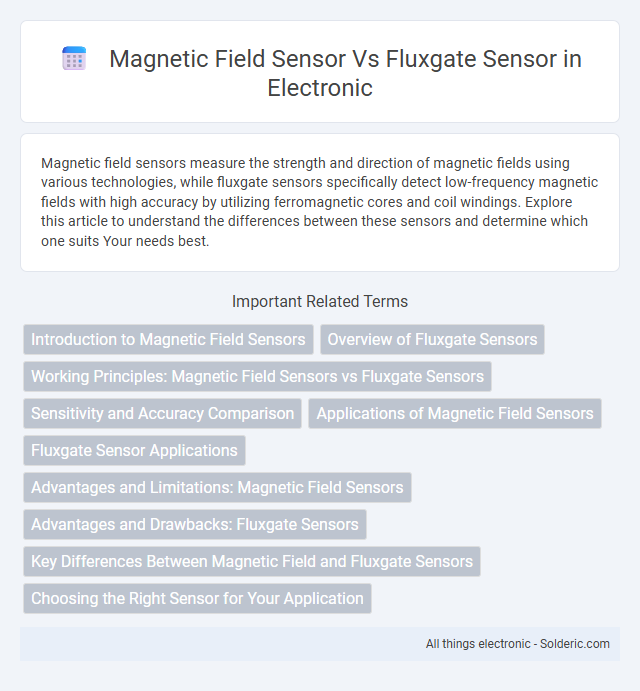Magnetic field sensors measure the strength and direction of magnetic fields using various technologies, while fluxgate sensors specifically detect low-frequency magnetic fields with high accuracy by utilizing ferromagnetic cores and coil windings. Explore this article to understand the differences between these sensors and determine which one suits Your needs best.
Comparison Table
| Feature | Magnetic Field Sensor | Fluxgate Sensor |
|---|---|---|
| Principle | Measures magnetic field strength using various technologies (Hall effect, magnetoresistance, etc.) | Uses nonlinear magnetization of a ferromagnetic core to detect magnetic fields precisely |
| Sensitivity | Moderate to high, varies by type | Very high sensitivity, detects low magnetic fields (nT range) |
| Accuracy | Good, depends on sensor type | Excellent accuracy and stability |
| Frequency response | Broad, varies among sensor types | Low-frequency applications, typically DC to few kHz |
| Size | Compact, varies | Generally larger due to core and coils |
| Power Consumption | Low to moderate | Moderate to high due to excitation coil |
| Applications | Consumer electronics, automotive, industrial | Geophysics, space research, navigation, military |
Introduction to Magnetic Field Sensors
Magnetic field sensors detect and measure the strength and direction of magnetic fields, playing a crucial role in applications such as navigation, industrial automation, and scientific research. Fluxgate sensors, a specialized type of magnetic field sensor, offer high sensitivity and accuracy for detecting low-intensity magnetic fields, making them ideal for geomagnetic surveys and space exploration. Your choice between these sensors depends on the required precision, sensitivity, and environmental conditions for your specific application.
Overview of Fluxgate Sensors
Fluxgate sensors are highly sensitive magnetic field sensors designed to measure the intensity and direction of low-frequency magnetic fields with high precision. They operate by detecting changes in magnetic permeability within a ferromagnetic core, enabling accurate measurements in geophysical surveys, aerospace navigation, and industrial applications. Fluxgate sensors exhibit superior sensitivity compared to Hall-effect or magnetoresistive sensors, making them ideal for detecting weak magnetic signals.
Working Principles: Magnetic Field Sensors vs Fluxgate Sensors
Magnetic field sensors primarily operate by detecting changes in the magnetic field through effects such as the Hall effect, magnetoresistance, or inductive coupling, converting these changes into electrical signals. Fluxgate sensors utilize a core of ferromagnetic material that is magnetically driven into saturation by an alternating current; variations in the external magnetic field affect core saturation, inducing a measurable secondary signal related to the field strength. Unlike general magnetic field sensors, fluxgate sensors provide high sensitivity and vector measurement capabilities by detecting the nonlinear response of the core material to magnetic field variations.
Sensitivity and Accuracy Comparison
Magnetic field sensors and fluxgate sensors differ significantly in sensitivity and accuracy, with fluxgate sensors typically offering higher precision in detecting minute magnetic fields. Fluxgate sensors provide sensitivity down to nanotesla levels, making them ideal for applications requiring exact magnetic field measurements, while general magnetic field sensors often measure in microtesla ranges suitable for less demanding environments. Your choice depends on the specific accuracy requirements; fluxgate sensors excel when precision detection is critical.
Applications of Magnetic Field Sensors
Magnetic field sensors find diverse applications in navigation systems, automotive industry, consumer electronics, and industrial automation by detecting the strength and direction of magnetic fields. Fluxgate sensors, a subset of magnetic field sensors, are particularly valued for their high precision in geophysical surveys, space research, and military targeting systems where detecting minute magnetic variations is critical. You can leverage the strengths of each sensor type based on the required sensitivity and environmental conditions of your magnetic field detection application.
Fluxgate Sensor Applications
Fluxgate sensors excel in precise magnetic field measurements for geophysical surveys, navigation systems, and space research, offering high sensitivity and stability. Applications include detecting Earth's magnetic field variations, military target detection, and spacecraft attitude control. Your projects benefit from their ability to measure low-frequency magnetic signals with minimal noise, outperforming standard magnetic field sensors in accuracy.
Advantages and Limitations: Magnetic Field Sensors
Magnetic field sensors offer advantages such as compact size, low power consumption, and cost-effectiveness, making them ideal for various applications including consumer electronics and industrial automation. However, their limitations include lower sensitivity and accuracy compared to fluxgate sensors, especially in detecting weak or low-frequency magnetic fields. Your choice depends on whether you prioritize affordability and integration ease or require precise magnetic field measurements.
Advantages and Drawbacks: Fluxgate Sensors
Fluxgate sensors offer high sensitivity and excellent accuracy in measuring low magnetic fields, making them ideal for applications requiring precise detection, such as geophysical surveys and aerospace navigation. Their drawbacks include higher power consumption and complexity compared to simpler magnetic field sensors, which can limit their use in battery-powered or compact devices. You should consider the trade-off between performance and resource requirements when choosing fluxgate sensors for your magnetic field measurement needs.
Key Differences Between Magnetic Field and Fluxgate Sensors
Magnetic field sensors detect the presence and strength of magnetic fields using various technologies such as Hall effect or magnetoresistance, offering broad applications with moderate sensitivity. Fluxgate sensors specifically measure vector components of low-intensity magnetic fields with high precision and stability, utilizing a saturable core to detect changes in magnetic flux. The key differences lie in sensitivity, measurement accuracy, and operating principle, with fluxgate sensors excelling in detecting subtle magnetic variations while general magnetic field sensors provide faster and more versatile responses.
Choosing the Right Sensor for Your Application
Magnetic field sensors and fluxgate sensors both detect magnetic fields but differ significantly in sensitivity and application scope. Fluxgate sensors offer high precision for measuring weak magnetic fields, making them ideal for geophysical surveys, aerospace navigation, and medical diagnostics. You should choose a magnetic field sensor for general-purpose applications requiring broader detection ranges, while fluxgate sensors are best suited for high-accuracy needs where low noise and stability are critical.
Magnetic field sensor vs fluxgate sensor Infographic

 solderic.com
solderic.com